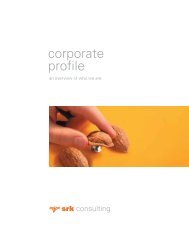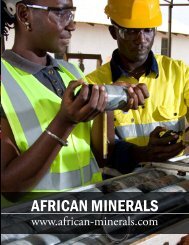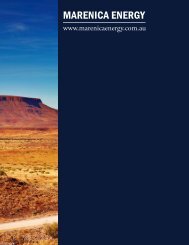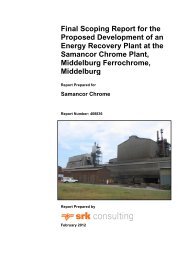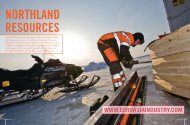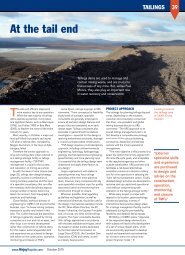Draft Status Quo Report for the Pixley Ka Seme ... - SRK Consulting
Draft Status Quo Report for the Pixley Ka Seme ... - SRK Consulting
Draft Status Quo Report for the Pixley Ka Seme ... - SRK Consulting
You also want an ePaper? Increase the reach of your titles
YUMPU automatically turns print PDFs into web optimized ePapers that Google loves.
<strong>SRK</strong> <strong>Consulting</strong> in association with BKS<br />
<strong>Pixley</strong> <strong>Ka</strong> <strong>Seme</strong> Local Municipality EMF – <strong>Draft</strong> <strong>Status</strong> <strong>Quo</strong> <strong>Report</strong> Page 47<br />
DIRECT USE<br />
- Consumptive<br />
e.g.food, timber<br />
- Non-consumptive<br />
e.g. tourism<br />
TOTAL<br />
ECONOMIC<br />
VALUE<br />
USE VALUE OPTION VALUE NON-USE VALUE<br />
INDIRECT USE<br />
- Regulating<br />
services e.g.<br />
carbon<br />
sequestration<br />
QUASI-OPTION<br />
VALUE<br />
Future use or<br />
delaying decisions<br />
until optimal<br />
decision may be<br />
reached<br />
BEQUEST VALUE<br />
-Payments <strong>for</strong><br />
future generations<br />
Figure 3-5: The TEV framework<br />
EXISTENCE<br />
VALUE<br />
- Knowledge that a<br />
resource exists<br />
natural environment. The water environment is<br />
important given <strong>the</strong> area’s importance <strong>for</strong> a number of<br />
major catchments. Services associated with natural<br />
terrestrial environments and <strong>the</strong> biodiversity that <strong>the</strong>y<br />
support are also prominent and help to maintain land<br />
productivity. The link between ecosystem services and<br />
continued sustainable production are clear. Option<br />
values and future use values are key to <strong>the</strong> EMF,<br />
particularly <strong>for</strong> areas that are growing rapidly. These<br />
values and <strong>the</strong>ir implications are <strong>the</strong>re<strong>for</strong>e assessed <strong>for</strong><br />
all major resource uses (Van Zyl, 2010).<br />
The interrelatedness of <strong>the</strong> environment, human welfare<br />
and economic development is shown in Figure 3-6.<br />
Figure 3-6: The link between Ecosystem Services<br />
and human well-being in <strong>the</strong> Millennium<br />
Ecosystem Assessment<br />
Key direct (consumptive and non-consumptive)<br />
resource uses identified <strong>for</strong> <strong>the</strong> study are:<br />
• Agriculture;<br />
• Tourism (focused on eco-tourism and heritage<br />
tourism) and recreation;<br />
• Mining (primarily coal);<br />
• Forestry;<br />
• Harvesting of resources from <strong>the</strong> natural<br />
environment; and<br />
• Aes<strong>the</strong>tic and cultural values not captured in<br />
tourism and recreational value.<br />
Key indirect uses or ecosystem services in <strong>the</strong> area are<br />
those associated with a healthy and sustainably utilised<br />
3.6.1 Overall economic trends and land<br />
use<br />
Economic development in PKSLM is primarily driven<br />
by <strong>the</strong> agriculture, <strong>for</strong>estry, mining and tourism sectors.<br />
Growth of <strong>the</strong> economy has approximately matched that<br />
of <strong>the</strong> national economy (Van Zyl, 2010).<br />
3.6.2 Agriculture<br />
The robust commercial agricultural sector, as well as<br />
<strong>the</strong> subsistence sector, are central to <strong>the</strong> economy of<br />
both PKSLM and <strong>the</strong> region. Agriculture is <strong>the</strong><br />
Province’s largest employer, especially <strong>for</strong> low-skilled<br />
workers. It is likely that between 2,700 and 2,725 direct<br />
agricultural jobs are currently supported in <strong>the</strong> study<br />
area (Van Zyl, 2010).<br />
Additional water availability <strong>for</strong> irrigation agriculture is<br />
limited and fur<strong>the</strong>r access would most likely involve<br />
costly transfers. Thus significant expansion of irrigated<br />
agriculture would most probably require increased<br />
water efficiency. Opportunities <strong>for</strong> agricultural<br />
expansion can be found through, <strong>for</strong> example, <strong>the</strong><br />
development of niche markets and products, <strong>the</strong><br />
development of a strong agro-processing industry and<br />
agro-eco tourism development. Institutional constraints<br />
also play a key role in <strong>the</strong> development of agriculture<br />
(Jordaan and Jordaan, 2010).<br />
3.6.3 Tourism and recreation<br />
The national tourism industry has exceeded <strong>the</strong> growth<br />
of virtually all o<strong>the</strong>r sectors in <strong>the</strong> post-apar<strong>the</strong>id era.<br />
With indirect spending taken into account, tourism<br />
contribution to gross domestic product is about 8.3%<br />
(Van Schalkwyk, 2009). The Mpumalanga Tourism<br />
Growth Strategy (MTGS) notes that direct employment<br />
KILI/BEAT G:\404946_PIXLEY EMF\7REPORTS\<strong>Status</strong> <strong>Quo</strong> report\<strong>Draft</strong> report\<strong>Draft</strong> status quo report, July 2010.docx July 2010



